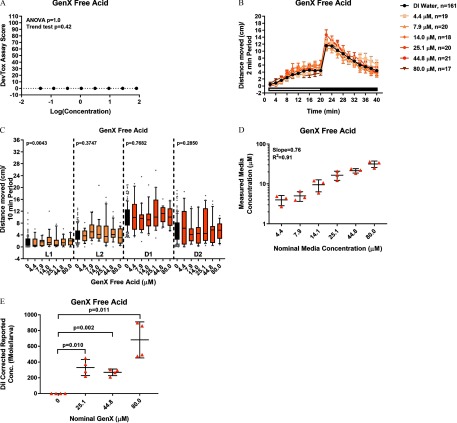Figure 6.
Developmental and behavioral assays and media and tissue concentrations in zebrafish exposed to GenX Free Acid diluted in DI water. (A) Developmental toxicity scores at 6 dpf obtained from zebrafish developmentally exposed to GenX Free Acid diluted in DI water daily, from dpf. Significance was determined by one-way ANOVA with a Tukey’s multiple comparison test (). larvae per concentration tested. For the DNT assay, zebrafish were exposed to GenX Free Acid daily, from dpf. At 6 dpf, locomotor activity was assessed. (B) Distance moved (cm) each 2-min period or (C) mean distance moved during the light 1 (L1), light 2 (L2), dark 1 (D1), or dark 2 (D2) 10-min periods are shown. Repeated measures ANOVA models were run separately by period (L1, L2, D1, or D2). If a significant effect of concentration was detected (), within-period pairwise comparisons to control were computed using t-tests with a Dunnett adjustment for multiple comparisons (*). zebrafish per concentration and 161 DI water control larvae were assessed. (D) Media concentrations and (E) internal tissue dose at 6 dpf following daily exposure to GenX Free Acid. media replicates and biological replicates each comprising 10 pooled larvae. Significance was determined by a Welch’s ANOVA followed by a Dunnett T3 test (). Additional one-sample Student’s t-tests were performed (). Note: ANOVA, analysis of variance; D, dark phase; DevTox, developmental toxicity; DI, deionized; Dil, dilution; DNT, developmental neurotoxicity; dpf, days post fertilization; GenX Free Acid, perfluoro-2-propoxypropanoic acid; L, Light period.

